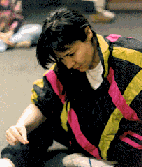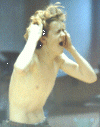Sense Memory For Actors
WHAT IS “SENSE MEMORY”?
If Relaxation is the foundation upon which rests the “house of method”, then Sense Memory is the structure of the house. Without it, the house is a transparent frame sitting on a solid foundation.
Simply stated, “sense memory” is the remembering by the five senses of the sensory impressions experienced by the individual organism in everyday life. These impressions are stored in the subconscious.
The actor can learn to recall these sensory impressions from the subconscious by concentrating on the stimuli associated with them.
If you have ever been hungry enough, and thought about your favorite food, chances are your mouth “watered”. This is an example of your senses remembering the taste of the food, and responding accordingly by activating your salivary glands.
Ever reach into a dark closet and pick out the clothing you want to wear just by touching it? Your senses “remember” the touch of the specific material of that particular article of clothing.
THE SENSE MEMORY EXERCISE
The sense memory exercise trains our senses to respond on the stage as they do in life. By concentrating on the stimuli associated with a sensory experience, a corresponding response should follow. And that response will be “real”, not just a conventional “indication” of the response.
If the actor believes that what he is doing on the stage is real, the audience will also believe that what the actor is doing is real. And creating “real” life is part of what the “method” approach is all about.
Since the author of the script has created the circumstances of his story from his imagination, the actor must know how to make those imaginary circumstances real to himself. The Sense Memory Exercise is a key to unlocking the door of imagined reality.
Faithfully executing a Sense Memory exercise each day will aid the actor not only in believing the truth of his life onstage, but in developing stronger powers of concentration.
Imagine for a moment you are an actor in a movie that takes place at the North Pole, but the actual scene you are doing is filming inside the studio. You are involved in a scene in which you have been stranded miles from civilization, and have little in the way of protective clothing. You find a small shelter between some rocks.
The director wants a couple of shots of you huddled between the rocks to show how miserably cold you are. One of the shots is a close-up.
The conventional actor can “play” this scene by indicating the cold in the usual way; shivering, wrapping his arms around himself, blowing his breath into his freezing hands to warm them up, etc. But you want to create the reality of the cold in stark detail.
To complicate your work, the studio lights are hot. The makeup artist visits you frequently to wipe the perspiration from your face, and touch up your melting makeup, and powder you.
But even before the director calls “Action!”, you have already begun creating the cold. You are sensorally recalling how the freezing cold affects you, because you have done this work as an exercise. You know that the cold affects the tip of your nose, and edges of your ears first. You know that your lips get numb quickly, and your fingers get stiff, and hard to move. You know that if you place your hands under your armpits, or down your pants and between your legs at the crotch, it will warm them up. You can feel your toes numbing. You warm your hands under your armpits, and place them momentarily over your ears, then back under your arms.
By doing the sensory exploration of how cold affects you, you have created for the director your own unique response to the cold. No other actor can imitate you. It’s your reality, and we, the spectator, believe you.
KEY TO REAL EMOTIONS
When the actor does a sensory exercise, he may find emotional responses occurring that he may not have anticipated. One of my favorite sensory exercises is creating a “place” my parents took me to when I was a young child. It’s a stream in the country, where my dad liked to fish.
When I start sensorally creating a particular visual aspect of the stream, “seeing” the cliffs that rise above it, and the “dragon flies” swarming about, and the water spiders darting to and fro, and the tadpoles and birds and clearness of the water, and cornfields and woods above the cliffs, and dozens of other details my sense of sight can remember when I am relaxed in a chair, something emotional happens to me.
Or when I “feel” the hot summer air on my young skin, and “smell” the stream and the vegetation, or “hear” the wind and the horseflies buzzing past my ear, or “taste” the water of the stream on my lips while dipping into it and the fresh fish Dad caught and Mom cooked over the open fire, I am totally transported to that place, which usually results in an emotional response: melancholy, or sadness.
I do not anticipate this response from that exercise. In fact, I was never melancholy or sad when I was actually at that place. I was usually very happy, unless I saw a snake or was stung by a bee.
But sensorally creating that particular place at this time in my life produces a quite different emotional experience from that of the original experience.
Why? I can only guess. Since that time, Mom and Dad divorced, and much later Mom died. Maybe going back to that place triggers sadness that the perfect world of the nine year old boy that was me then is missed, and longed for now.
Does it matter why? No. What matters is that by creating that particular place sensorally, I have an honest emotional response, and I can use that exercise to produce the same emotional response on stage or in front of a camera. And that makes me happy!
NOTE: After practicing this exercise several times, it only takes about 5 – 15 seconds for it to work. I never have to get beyond simply ” seeing” the stream, and I’m where I wish to be emotionally.

[Above] Actress Melissa Mayo is totally unaware of the camera as she sensorally creates a “personal object”.Although creating a simple sensory exercise,

[Above] While creating a “cold shower” sensory exercise, actor Philip Watt appears as though he might have just discovered his entire family brutally murdered.
THE EXERCISE
Strasberg developed these exercises over a period of time, until they became many in number, and combination. The student begins with a coffee cup as his first exercise.
The idea is to find a simple coffee cup at home, fill it with coffee or your favorite morning drink, and explore every sensory aspect of the cup in minute detail every day for at least fifteen minutes. Let your mind ask the questions, and your senses provide the answers. When you have done this, you are to recreate the cup without actually having the real cup as a reference. If the exercise is successful, you will actually “see”, “touch”, “taste”, “smell” and “hear” the cup and the coffee, as though it were there right in front of you. Your senses will faithfully recreate the cup and drink for you.
1) First, get in a chair and do the relaxation exercise.
2) When you are relaxed, begin exploring the cup with one of your five senses. I like to start with the sense of sight, because for me it is a very strong sense. As your eyes view the cup, your mind should answer every detail about the visual aspects of the cup: how tall is the cup? what is the diameter of the cup? what color is the cup? of what material is the cup made? what are the dimensions of the cup’s handle? are there ridges on the cup’s lips (what dimensions?)? is there artwork or ceramic design on the cup (what shape, color?)? are reflections from the lights in the room visible on the cup (where, what color?)? when do I first see the coffee inside the cup as I approach the cup to look in? is the cup glazed? are there flaws in the cup (what kind, what size?)?
3) After you have exhausted every possible question your mind has asked your sense of sight to answer, move on to another one of the five senses, such as “touch”, and explore in the same deliberate exhaustive manner.
4) Repeat this process for each of the senses, so that you should be able to ask the same questions and get the same answers when you no longer have the cup to refer to.
NOTE: There is no rushing through this exercise. The more time you take to explore, the better the exercise will serve you in your work as an actor. When you recreate the “imaginary” cup, it should not be pantomime, but an actual sensory exploration. You will find sensory elements of the cup appearing and disappearing as you work. This is normal.
The idea is to keep your concentration 100% focused on what you are doing. Oh, by the way, developing concentration is one of the side benefits of this exercise. Did I already say that?
I use the word “concentration” word a lot, if you haven’t noticed yet. Because the bottom line is, if the actor has not developed extremely strong powers of concentration, nothing he learns or attempts to do with his work will succeed.
For the actor, the powers of concentration and observation are much more highly developed than for his non-actor counterpart. It’s our job to study humankind and the world it lives in, and to bring the results of that observation to our work in a realistic way. For us, that’s the “art” of acting.
